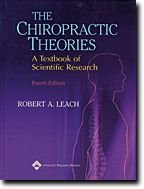| Title: | The Chiropractic Theories - A Textbook of Scientific Research, 4th edition |
| Author: | Robert A.
|
| Publisher: | Lippincott Williams & Wilkins, 2004 |
| Part #: | T-261 |
I had the pleasure and privilege to review the third edition of Dr. Leach's book in 1994, and I find myself privileged to review the fourth edition. Once again, the author has assembled an impressive array of contributors and an even more impressive body of knowledge concerning the state of chiropractic theories and their research. Critics of our profession who perpetually state that there is no research basis for chiropractic need only briefly skim the 463 pages of this edition to find there is an incredible amount of research that has been done, with admittedly, a significant amount yet to do, as acknowledged by Dr. Leach. The book is divided into five sections. The first section covers an introduction to subluxation theories. Depending on your chiropractic college and your reading of the literature, some of these theories may be new to you, but by reviewing them all, the author provides the framework for the remainder of the text. The chapters discuss the importance of theories to a profession; the history of the theories, beginning with manipulation prior to the development of the chiropractic profession; chiropractic terminology, including the differing definitions under which our profession operates; and philosophy as a foundation for theory development.
The second section is devoted to chiropractic research principles, beginning with a chapter on principles of measurement, research and statistics. This is an excellent primer on the language of research. For those of us never schooled in this topic, it provides us with the information to better read, understand and utilize the published research. There is a chapter discussing the strategy for validation of subluxation theories, a proposed minimum process that outlines the consensus process, including guidelines that have been developed and the development of a research agenda for chiropractic. The last chapter in this section talks about research and the scientist practitioner model. Dr. Leach often refers to himself as a scientist practitioner, and in this chapter, he presents the concept of the chiropractor as a clinical observer and researcher in the practice setting. He outlines the types of outcome measures to be used and their reliability. It gives the interested chiropractor an invitation to join in the process and some of the tools to be used.
Section three presents information on experimental and clinical evidence of the subluxation complex model. The hypotheses covered include inflammation, segmental dysfunction, instability, immobilization degeneration, neuropathology, somatoautonomic reflex, myelopathy, vertebrobasilar insufficiency, axoplasmic aberration and neuroimmune. No matter what your favorite hypothesis may be, you can be sure it is covered in detail and impeccable referenced. This section also has a chapter on the clinical aspects of manipulative effectiveness, encompassing both differentiated and undifferentiated disorders.
In section four, the topic of wellness is addressed, along with what a wellness model for chiropractic would include. A chapter on the social theory of chiropractic covers the concepts of health, disease, illness and chiropractic's role. The fifth and final section is dedicated to the future of chiropractic research. In this section, Dr. Leach covers some of the disproven and untested hypotheses, and asks the question: Is there experimental and clinical support for VSC? The last chapter poses new questions and explores into what areas research may yet delve.
Overall, the book is very well-written, with tables, diagrams and illustrations that assist the reader in understanding topics not common for many chiropractors. Dr. Leach has done a masterful job in getting a grasp on a subject that grows monthly, and presenting it in a concise and readable fashion. This is a book that belongs on the bookshelf of every chiropractor and chiropractic student. It is a book the profession can be proud to use as a reference.
Dr. Savoie's Rating:






